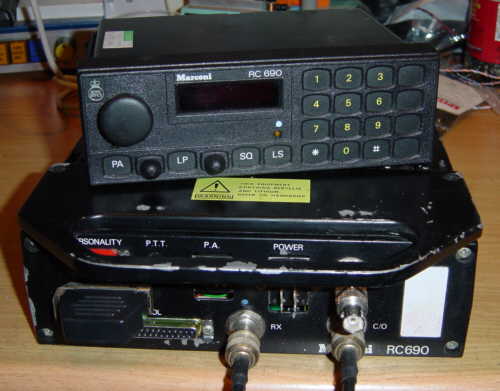 |
RC690 radio system
Control Head unit Radio unit |
What's this?
This is a page about the RC690 transceiver.
The RC690 "Repeater Mobile" is a boot-mount transceiver with a separate control head unit. It was made in the 1980's by Marconi, Chelmsford and sold to many police forces & ambulance fleets. "Repeater Mobile" comes from its ability to act as a repeater for the Police handhelds when the officers leave the vehicle. It is also classed a "Wideband" mobile due to the wide tuning band without factory realignment. RC690 is capable of full-duplex operation with two antennas but may also be fitted simplex with one.
I'm told about 3000 were were made.
There exists several variants:
- VHF mid-band duplex 143-156MHz
- VHF low-band simplex-only 70-84MHz
As I don't have the 70MHz unit all the following applies to the 144MHz radio.
Inside RC640
My RC690s were purhased for small change at the Stevenage amateur radio show. I have 3 sets complete with handsets and control units. Some had facilities bypass plugs and one had a short power lead with inline fuse. The radio units were all fairly dirty, but the control units were clean.
I have made my own interconnect cables.
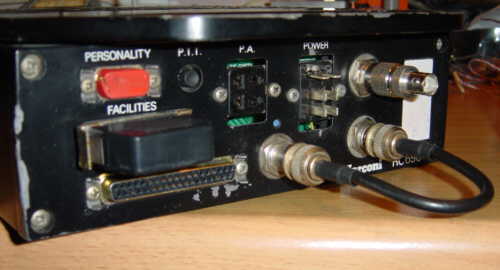 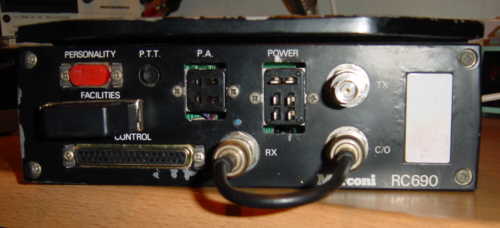 |
RC690 radio unit - front view
These BNCs with threads are called "TNC"s The TNC in the middle marked "RX" is the Rx antenna. The top right TNC marked "TX" is the Tx antenna. The bottom left TNC marked "C/O" the Rx port of the Tx/Rx switch. Link is shown for simplex, connect the antenna to the other socket where I have a TNC-BNC adaptor. Left top is the "personality" socket with as-yet unidentified features. Left centre is the facilities connector with link plug. Left bottom is the inter-unit cable socket. |
RC690 is a duplex radio; it has separate Tx and Rx synthesisers and antenna connectors.
RC690 can also work in simplex mode; it simply mutes Rx audio in Tx! There is an antenna switch relay provided for simplex single-antenna use.
RC690 can also operate as a repeater, using EEA selcall tone access. NB: no CTCSS. In this mode of operation it scans two channels for activity and will activate repeater operation in the appropriate direction.
The RC690 also has a PA (public address) mode which delivers substantial audio power to a speaker on top of the police car or perhaps behind the radiator grille. The "PA" button and and PA volume knob on the control unit control this function.
| Channels | 255 | |
| Frequency range | 143 � 156MHz | |
| Channel spacing | 12.5kHz | |
| Modulation | AM 80% mod depth | |
| Tx Power | 26W | (typical spec) |
| Rx sensitivity | -120dBm for 10dB SINAD @ 1kHz dev | Measured |
| IF bandwidth | +-3.5kHz | Measured |
| Power | 12V +ve or -ve earth 1.1A Rx, 7.0A Tx | Measured |
The radio supports detection and generation of 5-tone EEA-standard selcall tones. In fact the head-unit's tone generator can send almost any in-band tone (eg. 1750 Hz). Firmware only uses selcall for validating access to the repeater function.
The radio has a time-out timer which bleeps you shortly before expiry and then cuts off the Tx.
The radio is linked to the control head via a 15-way female-female D-type cable with all pins wired one-to-one.
The 15-way male "facilities" connectors on both the radio and control head must be fitted with link plugs to bridge the audio and PTT through.
A handset connects to the head unit with a 5-pin DIN plug; it is a black telephone-type with a pressel suitable for duplex working.
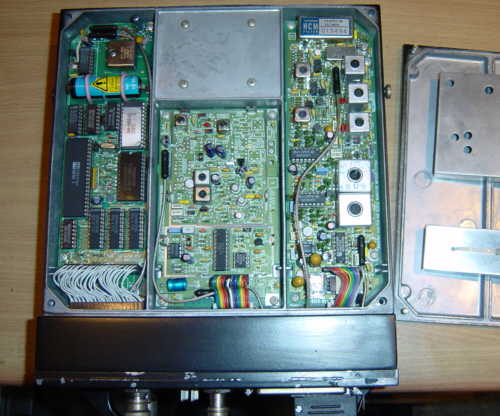 |
RC690 bottom view
Processor board on the right. The lithium cell is still good; over 3V. Note the frequency reference TCXO parked at the back. Rx synthesiser in the centre; screen covers removed. Rx RF, IF & demod is on the left. |
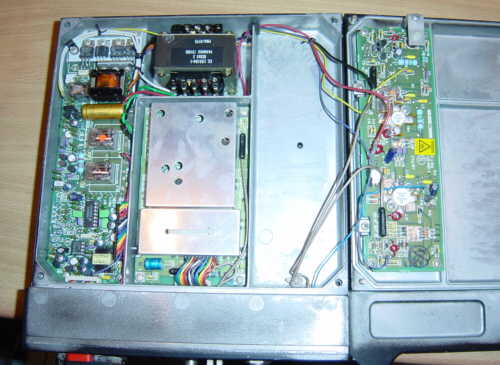 |
RC690 top view
The Modulator/Regulator is on the left. Tx synthesiser in the centre. Behind the synth is the modulation transformer The gap on the right takes the PA which is on the lid. |
Varicap voltage tuning is used in the Tx & Rx synth LO filters and Rx front end RF filters. No re-adjustment is needed for 2m band - unless you messed with them! It is designed like this to support a wide Tx/Rx split for duplex/repeater working and to work with Tx & Rx either way round. If you tweak, be aware the filter centre-frequency will shift with radio tune frequency; ie. set radio for 145MHz and set filters on 145MHz. Don't even look at them if the synths are off-frequency. Varicap tuning voltages are derived from the synth loops.
Receiver RV1 - Audio out to head unit level
Receiver RV2 -
Facilities Xfmr Balanced audio out level
Receiver RV3 - squelch detect
threshold
Mod-Reg RV1 - +9V supply current limit
Mod-Reg RV2 - +9V supply
volts
Mod-Reg RV3 - +10V supply current limit
Mod-Reg RV4 - +10V
supply voltage
Mod-Reg RV5 - AF deviation - control head (mic, CTC, EEA
tones)
Mod-Reg RV6 - AF deviation - ancilliaries (xfmr bal input pins
1&2)
At present I can't say how the PSU should be set up, don't fiddle. When I say "current limit", it's a protection of the LDO regulators that acts to prevent overdriving the pass transistors if the supply is overloaded or the input voltage is too low.
Filling
The channels are stored in the radio in battery-backed RAM.
Each channel can specify Tx & Rx synth setup, time out timer, CTCSS modes, and duplex mode. There is also some non-channel data including selcall identity and scanning dwell times.
The RC690 is intended to be loaded from a fill-gun unit connected in place of the control head. At the moment I have no idea what the gun looks like, although it appears to be the same gun as used with RC640. Although the channel data is different, it doesn't matter to the gun as it simply transfers a RAM-image. The gun, in turn, received its fill from another device. In later days PC-based software was produced to generate radio configuration files and transfer them to the fill gun.
The gun essentially transfers records of intelhex using a serial handshaking protocol. Fills have versions and editions and radio types, and so the appropriate fill selection becomes automatic when simply updating a radio. Fills also have a "status block" which contains a checksum and version info; checksum is only ever checked after filling and never at powerup.
The serial interface between the radio and control head is RS422; 2400 baud, 1 start, 7 data, odd parity, 1 stop. At powerup, the radio sends the letter "C" at intervals and awaits an "H" reply from a control head or a "G" from a fill gun.
Operation
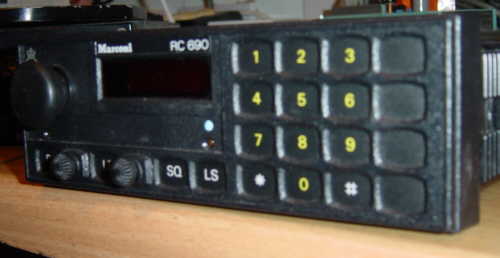 |
RC690 control head front view.
There is a slide-in mounting bracket, but there are also has spring clips to retain the head unit in a square dashboard opening. The main unit also takes a bracket but I haven't got one. |
Big knob - push/pull the knob in to switch off/on. Turn to set volume. If it won't click when you push/pull then tighten the allen grubscrew!
The decimal point in the display shows it's on. If it's dim that's normal; if it comes on bright it's an indication the CPU is not running and is not scanning the display & polling the keypad.
Channels are entered by pressing "*" followed by two digits and another "*". "00" is illegal.
# key (cancel) - cancels an unfinished entry or cancels repeater mode.
HP key - (REPh) - repeater mode
R key - (REPnn) - repeater mode. Follow by 2 digit channel and "*".
The difference in REP and REPh is the channels used. My theory is that one offers a local repeat between handhelds and the other between handhelds and HQ.
T/T key - function is unknown. The key is blank on some units. A selftest key?
S key - shows the 5-digit selcall number. At one time it was also possible to edit the selcall.
PA (public address) key - enables Public Address mode, indicated by green LED. Mic no longer activates transmitter but audio goes to speaker output on radio unit. This feature is almost a by-product from the audio amplifier used for high-level AM modulation of the RF PA.
Between PA key and LP key is a small knob which adjusts the PA volume.
LP (lamps) key - turns off/on the keypad illumination (on by default).
Between LP and SQ is a small knob that dims the display and illumination.
SQ (squelch) - pressing this toggles squelch-mute. Squelch is on by default.
LS (loudspeaker) button - enables the loudspeaker, indicated by the amber LED. Speaker is always muted when keyed in Tx Duplex to prevent feedback.
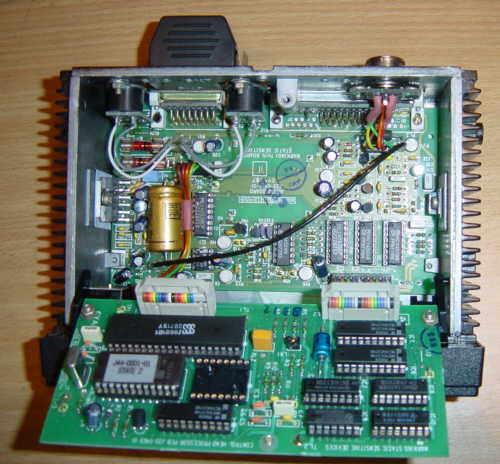 |
RC690 control head - top view with board open
Note link plug in facilities connector. |
| RC690 Power connector pinout - ??? with 6 pins - chassis male | |
| pin 1, 3, 5 | supply +12V |
| pin 2, 4, 6 | supply 0V |
The radio chassis is DC isolated from supply 0V although chassis is RF ground.
| RC690 Handset connector pinout - 5-pin DIN 240 degree | |
| pin 1 | - mic |
| pin 2 | - 0V |
| pin 3 | - PTT |
| pin 4 | - ear |
| pin 5 | - 0V |
The magnetic mic is connected between 1 (yellow) & 2 (green).
The earpiece is connected between 2 (blue) & 4 (grey).
The PTT switch is connected between 3 (pink) & 5 (white).
For duplex, some kind of handset or headset is required. I recommend separate ground wires for mic and ear back to the connector to avoid crosstalk. Fist speaker-microphones could be used for simplex if they have separate mic and speaker or if the PTT switch will swop the connections. Note that fist mics usually have PTT-to-ground; to rewire it you need at least 5 wires in the cable.
One warning: Don't short the PTT to +12V as it connects directly to the processor, which will probably die instantly. In fact ESD protection is lacking on many signals. The PTT pin is next to the +12V pin on the facilities connector.
| RC690 Facilities connector pinout - 15-way D-type chassis male | ||
| pin 1 | - Tx audio xfmr balanced input | |
| pin 2 | - Tx audio xfmr balanced input | |
| pin 3 | - 0V | |
| pin 4 | - PTT in | 1=Tx (HCMOS 5V signal) |
| pin 5 | - Tx audio in | |
| pin 6 | - 0V | |
| pin 7 | - Rx audio in | |
| pin 8 | - Mute out | 1=muted (HCMOS 5V signal) |
| pin 9 | - Rx audio xfmr balanced out | |
| pin 10 | - Rx audio xfmr balanced out | |
| pin 11 | - +12V | |
| pin 12 | - PTT out | 1=Tx (HCMOS 5V signal) |
| pin 13 | - Tx audio out | |
| pin 14 | - 0V | |
| pin 15 | - Rx audio out | |
For normal operation, a facilities bypass plug must be fitted at both radio and control head with the following pins linked:
| pin4 - pin12 | pin5 - pin13 | pin7 - pin14 |
| RC690 Inter-unit cable pinout - 37-way D-type - chassis female(radio) male(head) | |
| pin 4 | - +12V |
| pin 7 | - on/off switch A |
| pin 8 | - on/off switch B |
| pin 9 | - Rx AF from radio |
| pin 10 | - +12V |
| pin 11 | - bal AF ancilliaries Tx in |
| pin 12 | - bal AF ancilliaries Tx in |
| pin 13 | - TxD+ |
| pin 14 | - RxD- |
| pin 22 | - 0V |
| pin 26 | - 0V |
| pin 27 | - 0V |
| pin 28 | - Tx AF to radio |
| pin 29 | - bal AF ancilliaries Rx out |
| pin 30 | - bal AF ancilliaries Rx out |
| pin 31 | - TxD- |
| pin 32 | - RxD+ |
| pin 35 | - +12V |